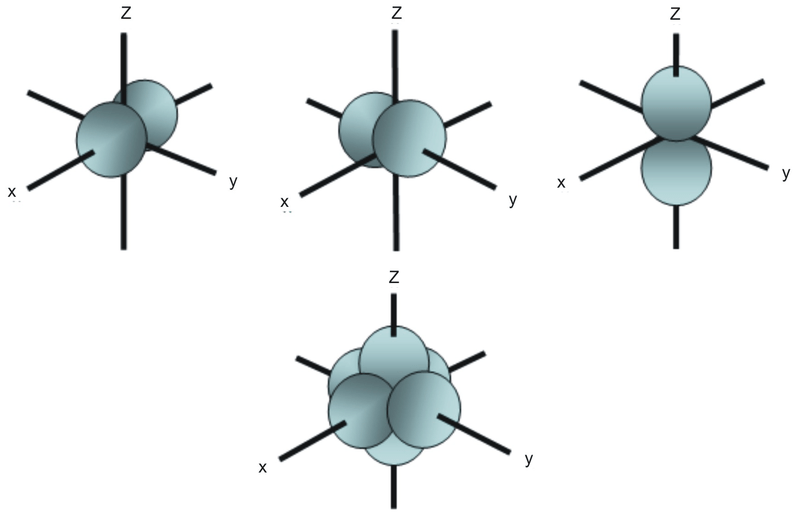Difference Between Hybrid and Degenerate Orbitals
The key difference between hybrid and degenerate orbitals is that hybrid orbitals are new orbitals that form from the mixing of two or more orbitals, whereas degenerate orbitals originally exist in an atom.
As its name implies, a hybrid orbital is a hybrid of two or more orbitals. Although the name degenerate orbital seems the same, they are not newly formed orbitals – they already exist in an atom. Moreover, all the hybrid orbitals in a molecule have the same energy while degenerate orbitals in an atom have the same energy.
CONTENTS
1. Overview and Key Difference
2. What are Hybrid Orbitals
3. What are Degenerate Orbitals
4. Side by Side Comparison – Hybrid vs Degenerate Orbitals in Tabular Form
5. Summary
What are Hybrid Orbitals?
Hybrid orbitals are orbitals formed by the combination of two or more atomic orbitals. We call this combination process hybridization. Before the formation of these orbitals, the atomic orbitals may have different energies, but after the formation, all orbitals have the same energy. For example, an s atomic orbital, and a p atomic orbital can combine to form two sp orbitals. The s and p atomic orbitals have different energies (energy of s < energy of p). But, hybridization results in the formation of two sp orbitals having the same energy; this energy lies between the energies of individual s and p atomic orbital energies. Moreover, this sp hybrid orbital has 50% s orbital characteristics and 50% p orbital characteristics.

Figure 01: Sp Hybridization
The idea of hybridization first came into the discussion because scientists observed that valence bond theory fails to correctly predict the structure of some molecules such as CH4. Although the carbon atom has only two unpaired electrons according to its electron configuration, it can form four covalent bonds. In order to form four bonds, there must be four unpaired electrons. The only way to explain this phenomenon was to think that s and p orbitals of carbon atom fuse with each other to form new orbitals called hybrid orbitals, which have the same energy. Here, one s + three p gives 4 sp3 orbitals. Therefore, electrons fill these hybrid orbitals evenly (one electron per hybrid orbital), obeying the Hund’s rule. Then, there are four electrons for the formation of four covalent bonds with four hydrogen atoms.
What are Degenerate Orbitals?
Denigrate orbitals are the atomic orbitals having the same energy. For example, in p orbital subshell, there are three atomic orbitals that differ from each other according to the spatial arrangement. Although the energy of these three p orbitals is the same, they are differently arranged; therefore, we call them degenerate orbitals.

Figure 02: Spatial Arrangement of Three p Orbitals
However, in the presence of an external magnetic field, we can remove the degeneracy. It is because degenerate orbitals tend to get different energies in the presence of this external magnetic field, and they are no longer degenerate orbitals. Furthermore, five d orbitals in the d subshell are also degenerate orbitals because they have the same energy.
What is the Difference Between Hybrid and Degenerate Orbitals?
The key difference between hybrid and degenerate orbitals is that hybrid orbitals are new orbitals formed by the mixing of two or more orbitals, whereas degenerate orbitals are orbitals that originally exist in an atom. Furthermore, hybrid orbitals are molecular orbitals, while degenerate orbitals are atomic orbitals. Moreover, hybrid orbitals are molecular orbitals having the same energy while degenerate orbitals are atomic orbitals having the same energy. For example, sp, sp2 and sp3 orbitals are hybrid orbitals while three p orbitals in p subshell.

Summary – Hybrid vs Degenerate Orbitals
Hybrid orbitals are molecular orbitals while degenerate orbitals are atomic orbitals. The key difference between hybrid and degenerate orbitals is that hybrid orbitals form by the mixing of two or more orbitals, whereas degenerate orbitals originally exist in an atom.
Reference:
1. Helmenstine, Anne Marie. “Hybrid Orbital Definition.” ThoughtCo, Jun. 22, 2018, Available here.
Image Courtesy:
1. “Sp hybridization” By Tem5psu – Own work (CC BY-SA 3.0) via Commons Wikimedia
2. “Px py pz orbitals” By CK-12 Foundation – File:High School Chemistry.pdf, page 268 (CC BY-SA 3.0) via Commons Wikimedia
ncG1vNJzZmivp6x7pbXFn5yrnZ6YsqOx07CcnqZemLyue8OinZ%2Bdopq7pLGMm5ytr5Wau2602JupopxdlrulecOenp6mlaeutbGMqKmboaSWubR7